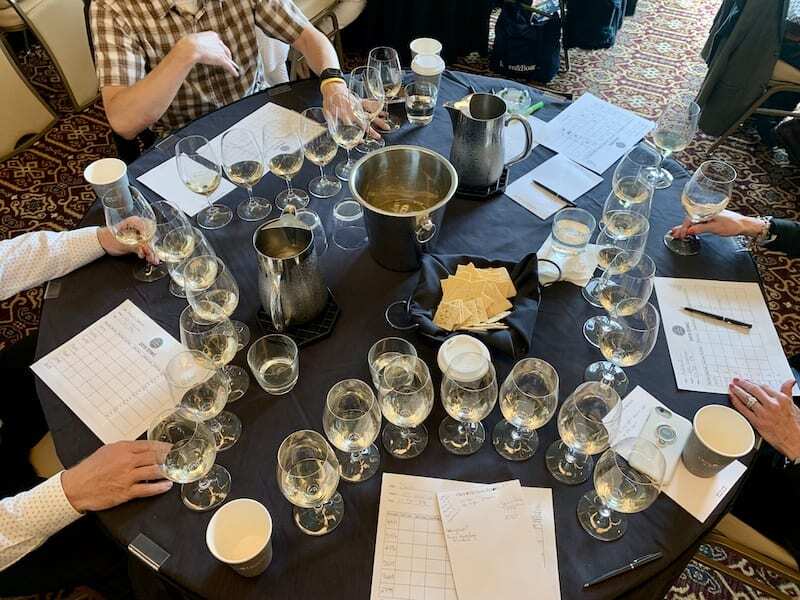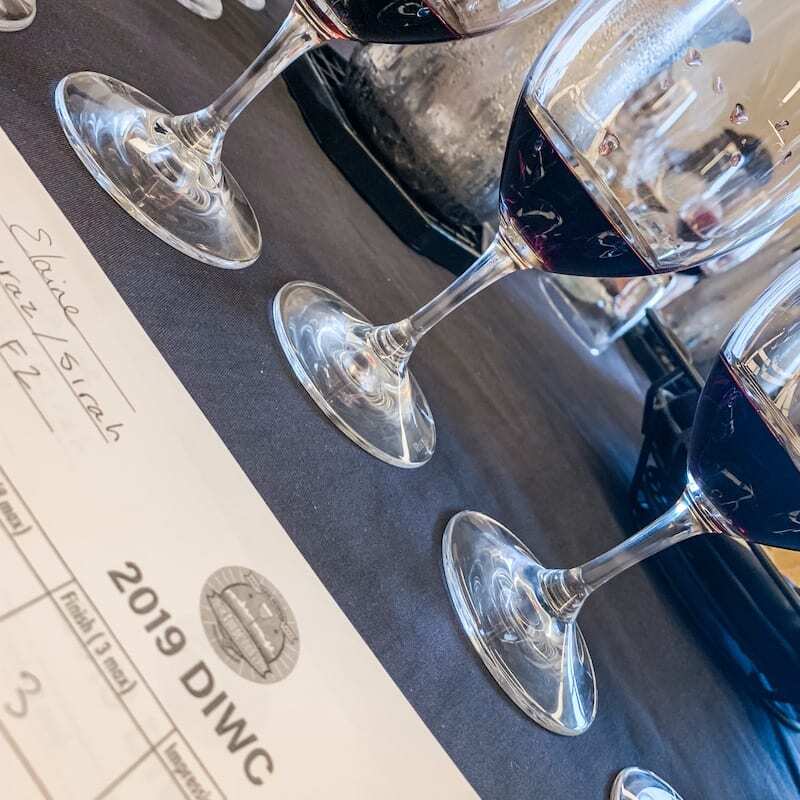Simone FM Spinner, CWS, MH
Have you always wondered how professional sommeliers come up with all of those tasting notes? Are you getting the most out of your wine tastings and wine drinking experiences? Read on for a brief introduction to learn how to taste wine and increase your enjoyment along the way.
How to Taste Wine Like a Pro
Wine tasting doesn’t have to be mysterious or intimidating. After all, wine is just another beverage, right? Actually, wine is one of the most complex beverages you will ever taste. It is more complex than any food you will ever try. Wine is a mystery to a lot of people. But it doesn’t have to be.
You can learn to taste wine like a professional sommelier by following a few simple rules and a structure that somms call “The Grid.” Whether you are a casual sipper, an aficionado, or wish to break into the wine business, you can easily improve your tasting technique and your enjoyment while sipping and spitting, or just drinking wine.
The most important thing you need to bring to tasting wine is an open mind. Don’t arrive with preconceived notions of what is supposed to be in your glass. Shut your ears and eyes to what tasting notes, critics, friends, and foes, are claiming to taste. Approach each glass fresh and let it reveal itself to you.
Tasting isn’t drinking and if you are going to learn to taste, taste separate from drinking and dining.
As you master this technique, incorporate it into your drinking and dining experiences. Once you learn how to taste, you will be able to taste wine, or anything at all, quickly and efficiently. It really is that simple.

Tips for How to Taste Wine
Select a quiet, bright room, with a table and a white table cloth or several sheets of unlined white paper.
Make sure that there are no aromas that will interfere with your ability to identify your tasting and aroma notes. Remove air fresheners, candles, incense, or foods.
Have a glass of water handy and some plain, unsalted crackers. It is useful to have an extra glass or small bucket to spit in and dump your unused wine into.
Don’t be afraid to spit! Some clever somms treat spitting like a sport!
Make sure you have a notebook and a pen to jot down your notes.
Professional sommeliers accumulate hundreds if not thousands of tasting notes over their lifetimes.
Use an unadorned, plain, moderately sized, CLEAN wine glass.
Bring your wines to a proper service temperature because they will warm up during your tasting experiments.
Pour one to two ounces in the glass, no more.
Sight - Swirl - Sniff - Sip, Swish, Slurp - Spit, Swallow
Sight
Take a critical look at your wine, straight on, as you hold the glass out in front of you. What do you see? Is your wine clear or opaque? Are there bubbles? Are they supposed to be there? What is the color of your wine? Is it dense or pale? Red, pink, or white? Break down that color. It is a clue to the varietals in your glass.
Tilt your glass to a 45-degree angle over the white cloth or paper. View the wine directly from above. What do you see? Is there a densely colored core at the center? Is the edge, or rim translucent or clear? If so, how many millimeters are clear?

Swirl
Give your wine a generous swirl. It takes practice to swirl without spilling. After decades, I just place the base of my glass on the table for stability and gently make circles with my wine. You will find your own rhythm.
Observe the width and length of the tears or legs that trickle down the side of the glass after a good swirl. This can indicate viscosity and alcohol levels in the wine.
Sniff
Bring the glass to your nose, holding it on a 45’angle and stick your nose right in the glass toward the bottom rim. Take a nice long inhale and slowly move the glass so your nose ends up at the top rim. Breathe in all of those beautiful aromas.
What do you smell? Flowers, fruit, herbs, spices, cigar box, and minerals? Jot down anything of note. Dig deep and peel back the layers. What kind of flowers do you detect? Is your fruit under ripe, ripe, stewed, baked, jam? How about those spices? Or oak? Do you find the coconut and dill of American oak or French oak’s pie spice and vanilla? That will tell you a lot about the wine.
Make a note of any noticeable faults. Do you smell wet newspapers or wet dogs? What about burnt matches or nail polish? Does it smell dirty or funky? It may be faulted. If it falls flat on your palate, it probably is.

Sip, Swish, Slurp
Your mouth can only taste five things. You heard that right: just five things; salt, sweet, acid, tannic/astringent (more dry than a taste), and umami/savory (like soy sauce or mushrooms). Everything else that you think you taste is actually smell!
How does that work? It is called nasal and retronasal olfaction. Aroma molecules travel to your brain sensory detectors through your nose when you sniff and into your olfactory center as you sip by sneaking into your nasal passage through the back of your mouth. You will recall, that when your nose is stuffed up, that you can’t taste a thing. That is because aroma molecules can’t travel through this hidden back door. Test this theory by holding your nose closed and taking a sip of wine. You will only taste salty, sweet, acid, tannins, and umami.
Is the wine sweet or simply fruity? Sugar will leave a little tingle on the tip of your tongue. Does the wine make you pucker and salivate? That’s high acidity. After you sip a red wine or an oaky Chardonnay, smile and take a quick breath in. Do your teeth and gums feel dry? High tannins. Is your wine earthy with notes of forests after a rain or a horse barnyard? That can be umami or another quality called brettanomyces.
Is the wine balanced and harmonious? Is everything just as it should be or does one or more qualities stand out? Is the alcohol out of balance and hot in your mouth? Is it silky or velvety? Is the acidity bracing and fresh? Different grape varietals impart different qualities.
Jot down the tastes and the aromas you detect. Swish the wine around in your mouth. Slurp it between your teeth while inhaling just a bit of air. You may drool and dribble in the beginning. We all do. You will get it. I promise.
Spit or Swallow
This is a judgment call and a means of maintaining a clear head while you are tasting. Some days, I will taste a hundred wines in one day! I have to spit or I can’t function.
It is true, that when you swallow your wine, the tiny taste buds at the very back of your tongue will send additional signals to your brain altering your tasting and smelling experience. It is ok to avoid that little boost by spitting.
Keep practicing. This tasting method will make you a better taster by slowing you down. You will become a fantastic taster and you will love wine more because of it.

Simone FM Spinner, CWS, MH
Simone FM Spinner is a top-rated university wine lecturer and certified sommelier with thirteen advanced wine certifications, a bachelor’s and master’s degree in wine studies, and is pursuing her doctorate studying the socioeconomic and cultural effects of climate change on wine. She is a sought-after wine consultant, public speaker, and published author. She organizes wine events and international wine tours through her company Wine Rocks & Chasing Grapes™©. Her website is WineRocksLLC.com
Simone FM Spinner is a top-rated university wine lecturer and certified sommelier with thirteen advanced wine certifications, a bachelor’s and master’s degree in wine studies, and is pursuing her doctorate studying the socioeconomic and cultural effects of climate change on wine. She is a sought-after wine consultant, public speaker, and published author. She organizes wine events and international wine tours through her company Wine Rocks & Chasing Grapes™©. Her website is WineRocksLLC.com

